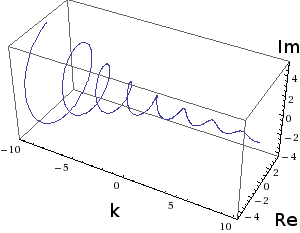Can anyone explain how frequency response related to a transfer function?
2 Answers
A discrete-time linear time-invariant (LTI) system is defined by its impulse response, which can be expressed as a list of non-zero coefficients $c_n$ occuring at integer time indices $t_n$. To form its output $y[k]$ all the system can do is sum time-shifted and constant-multiplied copies of its input $x[k]$. An important class of input functions are complex exponentials that look for example like this:
If the input is a complex exponential: $$x[k] = az^k,$$ where $a$ and $z$ are complex constants and $k$ is the integer time index, then summation results in an output that is the same as the input multiplied by a constant $H(z)$: $$y[k] = \sum_n c_n x[k-t_n] = \sum_n c_n a z^{k-t_n} = \left(\sum_n c_n z^{-t_n} \right)a z^k = H(z)\,x[k].$$ In other words, complex exponentials are eigenfunctions of LTI systems. The constant $H(z)$ is called the transfer function. It is a function of the base $z$ of the complex exponential. If $|z|$ = 1, then the base is of form: $$z = e^{i\omega} = \cos(\omega) + i \sin(\omega),$$ where $i$ is the imaginary unit, and the system's input is a complex sinusoid of real frequency $\omega$ (with magnitude and phase embedded in the constant $a$): $$x[k] = a (e^{i\omega})^k = a e^{i\omega k} = a\left(\cos(\omega k) + i \sin(\omega k)\right)$$ Compared to other complex exponentials, complex sinusoids don't decay or increase in magnitude by time. Frequency response at frequency $\omega$ is simply the constant $H(e^{i\omega})$ by which the system multiplies a complex sinusoid input of frequency $\omega$.
By the inverse Fourier transform, one can go from the frequency response to the impulse response, and from the impulse response one can obtain the transfer function as shown above. So the transfer function of a discrete-time LTI system is fully defined by its frequency response.
An LTI system's "frequency response" tells you how the system acts on the amplitude and phase of a sinusoidal input. If the frequency response is $H(f)$, then an input $x(t)=e^{j2\pi f_0t}$ produces an output $y(t)=|H(f_0)|e^{j(2\pi f_0t+\angle H(f_0))}$. It is common to divide the frequency response in two, the gain $|H(f)|$ and the phase $\angle H(f)$.
The same system's "transfer function" is defined as follows: if an input $x(t)$ produces an output $y(t)$, then the system's transfer function is $H(s)=\frac{Y(s)}{X(s)}$, where $X(s)$ and $Y(s)$ are the Laplace transforms of $x(t)$ and $y(t)$.
When the transfer function is evaluated at $s=j\omega$, it is also known as the systems's frequency response. Note that the transfer function is more general than the frequency response, and can provide more insight into a system's behavior, for example about transient response or stability.
These definitions can also be extended to non-linear systems but that is beyond my experience.
-
$\begingroup$ Usually, $H(s)$ (in continuous time) or $H(z)$ (in discrete time) are referred to as transfer functions (having zeros and poles in the complex plane), whereas $H(j\omega)$ or $H(e^{j\omega})$ are referred to as frequency responses, i.e. the transfer functions evaluated for $s=j\omega$ or $z=e^{j\omega}$. $\endgroup$– Matt L.Commented Nov 8, 2015 at 9:51
-
$\begingroup$ @MattL. Thanks; I've edited my answer to take your comment into account. $\endgroup$– MBazCommented Nov 9, 2015 at 16:26

